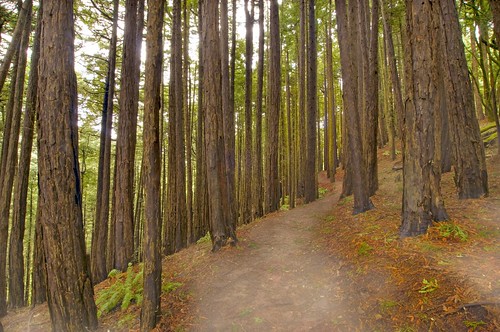After several days of savage rain, with violent wind and pelting water that the winter Pacific storms bring, Julian and I set out to photograph Cataract Falls on the slopes of Mount Tamalpais. The weather had partially cleared, but was still intermittently drizzling.
When we got to Pantoll Station we found that the Park Service had closed the road to the upper slopes of Mount Tamalpais. So we parked by the Dipsea Trail near Steep Ravine instead. Crossing the bridge towards the bottom of Steep Ravine, Julian and I headed up the moist stone and wood stairs, and into the redwood grove shown in the photo.
Digital photography is the art of combining one’s vision with the possible. What is possible changes with each generation of technology.
My new Nikon D300 has a feature called Active D-Lighting, which the camera manual describes as follows:
Active D-Lighting preserves details in highlights and shadows, creating photos with natural contrast. Use for high contrast scenes, for example when photographing brightly lit outdoor scenery through a door or window or taking pictures of shaded subjects on a sunny day.
Trying to deconstruct this manual-speak, my take was that Active D-Lighting provided the ability in-camera to extend the dynamic range of an image. In other words, Active D-Lighting might provide a jump start on the kind of layering of different RAW exposures that I use for most of my photos.
Overcast but bright skies lit the tops of the trees, the tree trunks themselves were almost hidden in darkness, and a light mist rose from the Dipsea Trail itself. This scene, with a great deal of contrast in dynamic range, seemed perfect for taking Active D-Lighting out for a trial run. I scrolled through the menus, and turned Active D-Lighting on to High.
While I was making my 5 second Active D-Lighting exposure, Julian was fooling around with his camera, moving it during his exposures to create images of ghost trees and people (people meaning me). Perhaps I’ll post one of Julian’s photos later.
I think Active D-Lighting did pretty well with the contrast range in this photo, with much less multiple RAW layer masking than I’m typically used to. But to really get a feel for the setting, I’m going to have to do some tests in a more controlled environment where I can keep good notes about each exposure and exactly what changes I’m making (this setting doesn’t appear in the EXIF data, so I’m on my own for keeping track of whether Active D-Lighting was on, and how it was set).
Related images: Yosemite Valley Forest Floor; Big Sticks.
[12-14mm zoom lens at 12mm (18mm in 35mm terms), 5 seconds at f/22 and ISO 100, tripod mounted.]

Pingback: Photoblog 2.0: » Photoblog 2.0 Archive: » Active D-Lighting